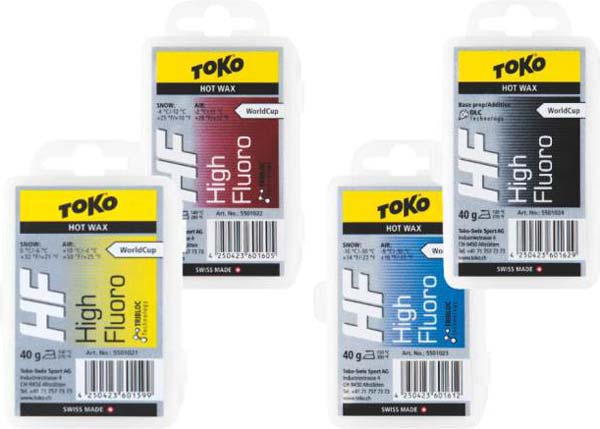
New Tribloc hot waxes from Toko
Fri, Nov 9, 2012 - By Toko
The new fluorine is called Tribloc. This is a spin-off of Dibloc where the molecule had two parts: hydrocarbon and fluorine. The Tribloc molecules have three parts: fluorine, hydrocarbon and fluorine. This enables us to get more fluorine in a molecule. Basically this ought to mean that our HF waxes will perform better in the red and yellow ranges than they have in the past. The performance of our blue waxes should be at least as good as in the past.
The new Tribloc waxes have been tested for 2 years and were used on the World Cup last year. We like to use the World Cup for the final phase of product development as the teams give very direct feedback. The Tribloc waxes are surely an improvement on the Dibloc waxes in basically all conditions. Tribloc and the old Dibloc waxes can be mixed without any complications.

We are using a harder paraffin in our waxes. This doesn't change the temperature ranges of the waxes though. The race service premixes white and orange tested well the last few years and were very popular. We took the hardness of the white (previously a blue/red mix) and made it the hardness of the new red. The new yellow is the hardness of last year's orange premix (a red/yellow mix).
The new antistatic is called DLC (Diamond Like Carbon). This is not a Toko product name, but rather the trade name of the substance which is made of carbon. The DLC name is because the molecular structure is very much like that of Diamond. Due to its molecular hardness, DLC is especially durable. It also has excellent antistatic and superb dirt repelling properties. It will be used much like we used Moly.
DLC does not increase the hardness of the base. The DLC itself is molecularly hard, but the wax isn't too hard. The DLC itself is really good against dirt and aggressive snow. In colder snow, HF Blue is great, but when it gets around freezing and warmer, you need a wax that is great against dirt and aggressive snow AND reasonably hydrophobic. This is the DLC.
